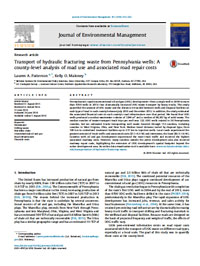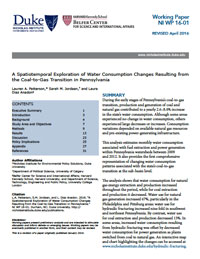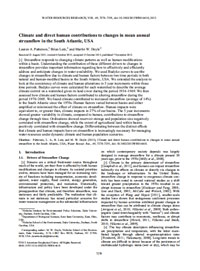Publications
Conservation Finance and Impact Investing for U.S. Water
The 2016 Aspen-Nicholas Water Forum focused on the shifting role of public and private financing for water infrastructure and the new universe of innovative financing solutions to create impacts in the water sector, including how impact investing can hold the multiple roles of bridging the ever growing funding gap for infrastructure, improve water use efficiencies, and protect water resources while at the same time making a financial profit. Among the forum report's key findings: (1) Business as usual is not sustainable—we as a society are now paying for the “can-kicking” that has occurred while we debated responsibility for U.S. water resources. (2) The water issues we face as a nation continue to grow as the water community dithers and invests in one-off projects, rather than focusing on scaled solutions like regionalization and integration. (3) Money is not the issue; there is plenty of private capital available to meet the current water funding gap, but there are significant barriers to impactful and innovative financing.
Transport of Hydraulic Fracturing Waste from Pennsylvania Wells: A County-Level Analysis of Road Use and Associated Road Repair Costs
Pennsylvania’s rapid unconventional oil and gas development—from a single well in 2004 to more than 6700 wells in 2013—has dramatically increased unconventional oil and gas waste transport by heavy trucks. In an article published in the Journal of Environmental Management, researchers at the Nicholas Institute for Environmental Policy Solutions and the U.S. Geological Survey report that transportation of waste associated with the development of unconventional oil and gas in Pennsylvania increases the cost of road repairs not only in Pennsylvania but in counties in the surrounding states of West Virginia, Maryland, New Jersey, Ohio, and New York. Between July 2010 and December 2013, the estimated cost to repair roads damaged by trucks transporting unconventional oil and gas waste ranged from $3 million to $18 million. Although the majority of these costs were concentrated in Pennsylvania (79 percent), Ohio counties absorbed some of them (16 percent). The study includes an interactive graphic for visualization of the data.
A Spatiotemporal Exploration of Water Consumption Changes Resulting from the Coal-to-Gas Transition in Pennsylvania
During the early stages of Pennsylvania’s coal-to-gas transition, extraction and generation of coal and natural gas contributed to a yearly 2.6–8.4% increase in the state’s water consumption. Although some areas experienced no change in water consumption, others experienced large decreases or increases. Consumption variations depended on available natural gas resources and pre-existing power-generating infrastructure. This analysis estimates monthly water consumption associated with fuel extraction and power generation within Pennsylvania watersheds between 2009 and 2012. It also provides the first comprehensive representation of changing water consumption patterns associated with the state’s coal-to-gas transition at the sub-basin level. The analysis shows that water consumption for natural gas energy extraction and production increased throughout the period, while for coal extraction and production it decreased. Water use for natural gas generation increased 67%, particularly in the Philadelphia and Pittsburg areas; water use for hydraulic fracturing increased nine fold in southwest and northeast Pennsylvania. By contrast, water use for coal extraction and production decreased 13%. In some areas, increased water consumption resulting from hydraulic fracturing was offset by decreased water consumption for power generation as plants switched from coal to natural gas. An interactive map and chart highlighting the changes can be accessed at www.nicholasinstitute.duke.edu/hydraulic-fracturing. These findings indicate the importance of considering the implications of energy production and generation choices in the context of both energy extraction and production sectors and of doing so at smaller-than-state-level scale.
Optimizing the Scale of Markets for Water Quality Trading
Allowing polluters to buy, sell or trade water-quality credits could significantly reduce pollution in river basins and estuaries faster and at a lower cost than requiring facilities to meet compliance costs on their own, a new Duke University led study finds. The scale and type of the trading programs, though critical, may matter less than just getting them started. The analysis in the journal Water Resources Research shows that water-quality trading of any kind can significantly lower the costs of achieving Clean Water Act goals.
Climate and Direct Human Contributions to Changes in Mean Annual Streamflow in the South Atlantic, USA
Streamflow responds to changing climate patterns as well as human modifications within a basin. Understanding the contribution of these different drivers to changes in streamflow provides important information regarding how to effectively and efficiently address and anticipate changes in water availability. In this study, published in the journal Water Resources Research, authors used Budyko curves to ascribe changes in streamflow due to climate and human factors between two time periods in both natural and human-modified basins in the South Atlantic. They found climate contributed to increased streamflow (average of 14%) in the South Atlantic since the 1970s. Human factors varied between basins and either amplified or minimized the effect of climate on streamflow. Human impacts were equivalent to, or greater than, climate impacts in 27% of our basins.
Characterization of Drought in the South Atlantic, United States
In this Journal of the American Water Resources Association article, authors aim to characterize drought in the South Atlantic and to understand whether drought has become more severe in this region over time using monthly streamflow to characterize hydrological drought. Significant changes in drought characteristics were tested with Mann-Kendall over three periods: 1930-2010, 1930-1969, and 1970-2010. Authors show that 71% of drought events were shorter than six months, while 7% were multiyear events. There was little evidence of trends in drought characteristics to support the claim of drought becoming more severe in the South Atlantic over the 20th Century. The one exception was a significant increase in the joint probability of nearby basins being simultaneously in drought conditions in the southern portion of the study area from 1970 to 2010. While drought characteristics have changed little through time, decreasing average streamflow in non drought periods, coupled with increasing water demand, provide the context within which recent multiyear drought events have produced significant stress on existing water infrastructure.






